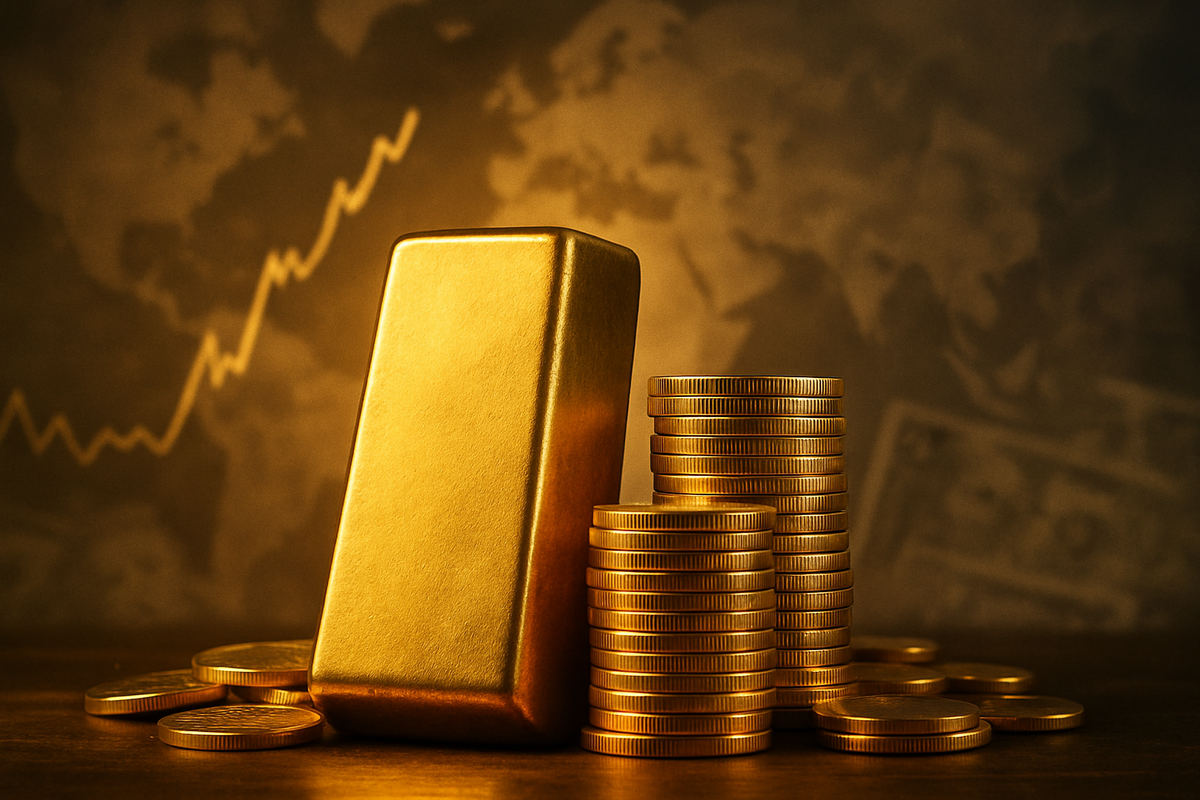Financial News
Gold Soars Past $4200: The Great Debasement Trade Ignites a New Golden Age for Precious Metals

For the first time in history, gold has surged past the unprecedented benchmark of $4200 an ounce on October 15, 2025. This monumental leap has ignited a wave of excitement and speculation across financial markets, with analysts at The Gold & Silver Club (GSC) heralding it as "the beginning of a new golden age" for precious metals. This era, they contend, is primarily fueled by "the Great Debasement Trade," a strategic investment paradigm driven by the erosion of fiat currency purchasing power.
The immediate implications of this historic surge are profound. Investors are flocking to gold as a safe haven amidst escalating global uncertainties, including anticipated interest rate cuts by the Federal Reserve, renewed US-China trade tensions, and persistent geopolitical instability. The precious metal's ascent reflects a growing lack of confidence in traditional financial instruments and a widespread search for tangible assets that can preserve wealth in an increasingly volatile economic landscape.
Unprecedented Ascent: A Deep Dive into Gold's Historic Rally
Gold's recent surge past $4200 an ounce marks a significant milestone, representing its 13th gain in the past 15 trading sessions. Spot gold reached $4,217.95 per ounce, while US gold futures climbed to $4,235.80 an ounce in New York. This remarkable performance solidifies 2025 as gold's best year since 1979, with a staggering 60% year-to-date increase.
The timeline leading up to this moment reveals a confluence of powerful economic and geopolitical forces. Expectations of further interest rate cuts by the US Federal Reserve, following a September reduction, have been a primary catalyst. Traders are now pricing in a 98% probability of a 25-basis-point Fed rate cut in October, with another fully anticipated for December. Simultaneously, a souring relationship between the US and China, characterized by new trade measures and 100% tariffs on Chinese goods, has reignited fears of a trade war, bolstering gold's appeal as a safe-haven asset.
Key players and stakeholders involved in this rally include central banks, which have been acquiring gold at historic levels to diversify away from US dollar-denominated assets and build strategic reserves. Investors, both institutional and retail, are also significant players, seeking to hedge against persistent inflation, a weakening US dollar, and broader de-dollarization efforts. Initial market reactions have been overwhelmingly positive for precious metals, with gold mining companies experiencing a significant boost, while other sectors sensitive to interest rate hikes or trade tensions face increased scrutiny.
Winners and Losers: Navigating the Golden Age's Impact
The "Great Debasement Trade" and the ensuing "new golden age" for precious metals will undoubtedly create a distinct landscape of winners and losers across various industries. Foremost among the beneficiaries are gold mining companies. Companies like Barrick Gold (NYSE: GOLD) and Newmont Corporation (NYSE: NEM) are poised to see substantial increases in their revenues and profits as the price of their primary commodity soars. Higher gold prices directly translate to improved profit margins and increased exploration budgets, potentially leading to new discoveries and expanded operations.
Conversely, industries heavily reliant on stable, low-inflationary environments or those with significant exposure to a weakening US dollar may face headwinds. Companies with substantial international debt denominated in foreign currencies could see their repayment burdens increase as the dollar depreciates against other major currencies. Furthermore, sectors that typically thrive during periods of strong economic growth and stable monetary policy might experience a shift in investor sentiment, with capital flowing away from growth stocks towards more defensive, inflation-hedging assets like gold.
The impact extends beyond direct commodity players. Financial institutions offering precious metal investment products, such as gold-backed ETFs and physical gold dealers, are likely to experience a surge in demand. Conversely, traditional bond markets could face continued pressure as investors seek alternatives to fixed-income assets that offer negative real returns in an inflationary environment. The broader implications for the global financial system involve a potential reallocation of capital away from fiat currencies and towards hard assets, signaling a fundamental shift in investment strategies.
Wider Significance: A Paradigm Shift in Global Finance
The surge in gold prices and the emergence of "the Great Debasement Trade" represent more than just a market anomaly; they signify a broader paradigm shift in global finance. This event fits into a wider trend of increasing skepticism towards traditional monetary policies, particularly those involving extensive quantitative easing and deficit spending. The persistent inflation, coupled with a weakening US dollar, has eroded confidence in fiat currencies, pushing investors towards tangible assets.
The potential ripple effects on competitors and partners are substantial. Other precious metals, such as silver, platinum, and palladium, are likely to follow gold's upward trajectory, benefiting from the same underlying drivers of monetary debasement and safe-haven demand. This could create a broader "new golden age" for the entire precious metals complex. Conversely, traditional financial assets, particularly those denominated in weakening currencies, could face increased pressure as capital flows towards more resilient stores of value.
Regulatory and policy implications are also significant. Central banks worldwide will be closely watching these developments, potentially re-evaluating their monetary policies and reserve management strategies. The increased demand for gold could prompt some nations to accelerate their de-dollarization efforts, further challenging the US dollar's global dominance. Historically, periods of significant monetary debasement have often been accompanied by increased demand for gold. Comparisons can be drawn to periods of high inflation in the 1970s, where gold served as a crucial hedge against currency devaluation.
What Comes Next: Navigating the Future of Precious Metals
In the short term, the momentum for gold appears strong. The confluence of anticipated interest rate cuts, geopolitical instability, and sustained central bank buying suggests that gold prices could continue their ascent. Analysts are projecting gold to potentially reach $5,000 per ounce by 2026, with some even forecasting $6,000 by spring 2026. This trajectory indicates a sustained bullish outlook for precious metals, driven by the ongoing "debasement trade" narrative.
In the long term, potential strategic pivots or adaptations will be required across various sectors. Central banks may need to adjust their reserve allocations, further increasing their gold holdings to hedge against currency volatility. Investors will likely continue to re-evaluate their portfolios, favoring assets that offer protection against inflation and currency debasement. Market opportunities will emerge in the form of new investment vehicles tied to precious metals, as well as increased demand for physical gold and silver.
Potential scenarios and outcomes include a continued weakening of the US dollar, leading to further diversification into alternative assets. There is also the possibility of increased volatility in equity and bond markets as investors grapple with shifting economic fundamentals. The "new golden age" for precious metals could reshape global investment strategies, prioritizing wealth preservation and inflation hedging over traditional growth-oriented approaches.
Wrap-Up: A New Dawn for Gold and Global Finance
The surge of gold past $4200 an ounce marks a pivotal moment in financial history, signaling a profound shift in market dynamics driven by "the Great Debasement Trade." The key takeaways are clear: unprecedented central bank buying, persistent inflation, geopolitical instability, and a weakening US dollar are collectively fueling a robust demand for gold as a safe haven and store of value.
Moving forward, the market is poised for continued volatility and a re-evaluation of traditional investment paradigms. Investors should remain vigilant, closely monitoring central bank policies, geopolitical developments, and inflation data. The "new golden age" for precious metals is not merely a fleeting trend but potentially a long-term structural shift, offering both opportunities and challenges for investors. The lasting impact of this event could be a fundamental reordering of global financial priorities, with tangible assets like gold playing an increasingly central role in wealth preservation and portfolio diversification.
This content is intended for informational purposes only and is not financial advice
More News
View More




Quotes delayed at least 20 minutes.
By accessing this page, you agree to the following
Privacy Policy and Terms Of Service.




